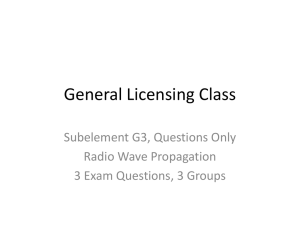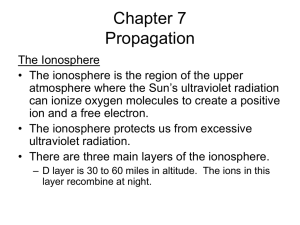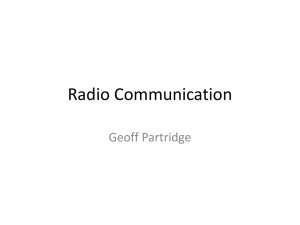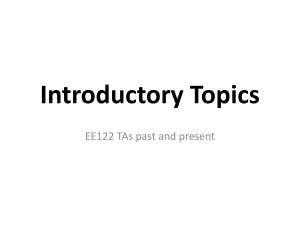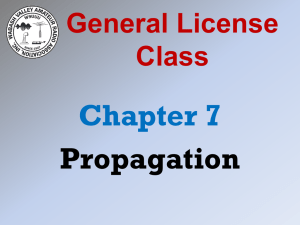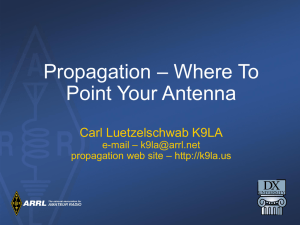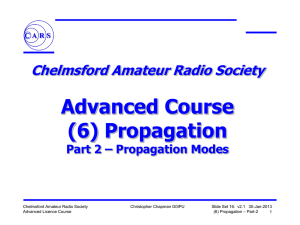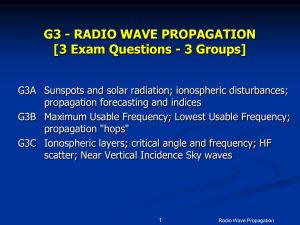G3 - Radio Wave Propagation
advertisement
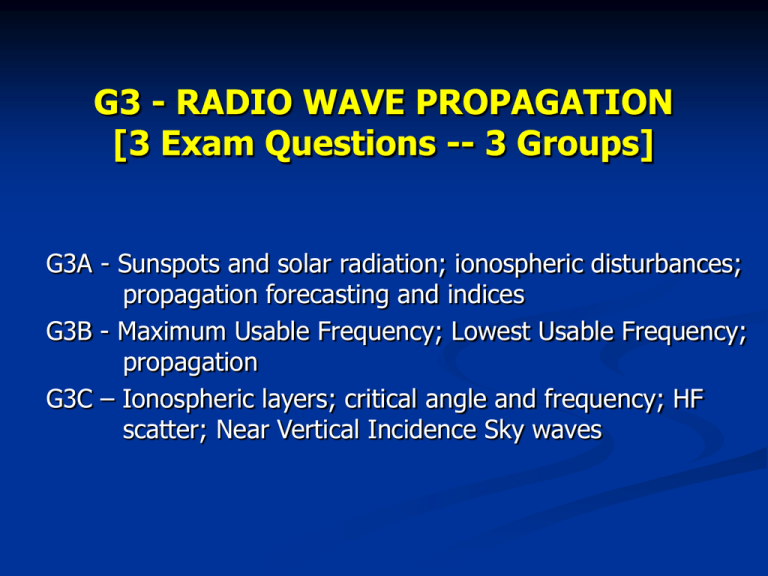
G3 - RADIO WAVE PROPAGATION [3 Exam Questions -- 3 Groups] G3A - Sunspots and solar radiation; ionospheric disturbances; propagation forecasting and indices G3B - Maximum Usable Frequency; Lowest Usable Frequency; propagation G3C – Ionospheric layers; critical angle and frequency; HF scatter; Near Vertical Incidence Sky waves Solar Effects Sun Spots Sunspots look darker because they’re cooler than surrounding areas but emit ultraviolet light that charge the Ionosphere. More sunspots mean improved upper HF and lower VHF propagation. Sun Spot Cycle Sunspots tend to come and go from minimum to maximum to minimum in an 11 year cycle. Different cycles have different maximums. Solar Emissions Electromagnetic emissions like ultraviolet and x-rays arrive at the earth in only 8 minutes. Particle emissions can take 20-40 hours to arrive at the earth where they are pulled to the poles by the earth’s magnetic field. Solar Rotation The sun rotates every 28 days (a solar day) 2 Measuring the Sun Solar Flux A measure of the sun’s noise at 10.7cm Solar K-index The K-index quantifies disturbances in the horizontal component of earth's magnetic field during a 3 hour interval with an integer in the range 0-9 with 1 being calm and 5 or more indicating a geomagnetic storm Solar A-index The A-index provides a daily average level for geomagnetic activity 3 Ionospheric Layers 4 Propagation Ionospheric Layers The Atmosphere is divided into layers A,B,C,D,E,F The Ionosphere consist of layers D, E, and F The D layer absorbs low frequencies The F layer typically reflects radio waves < 30 MHz Refraction E layer refraction can be 1200 miles The higher altitude F layer refraction can be 2500 miles Balancing Absorption and Refraction D layer absorption defines Lowest Usable Frequency (LUF) E and F layer refraction determine Maximum Usable Frequency (MUF) 5 Solar Particles and the Magnetosphere Solar particle emissions are largely deflected by the earth’s magnetic field. Some are drawn to the poles and generate auroras. 6 Critical Angle 7 G3A01 What is the sunspot number? A. A measure of solar activity based on counting sunspots and sunspot groups B. A 3 digit identifier which is used to track individual sunspots C. A measure of the radio flux from the Sun measured at 10.7 cm D. A measure of the sunspot count based on radio flux measurements 8 G3A01 What is the sunspot number? A. A measure of solar activity based on counting sunspots and sunspot groups B. A 3 digit identifier which is used to track individual sunspots C. A measure of the radio flux from the Sun measured at 10.7 cm D. A measure of the sunspot count based on radio flux measurements 9 G3A02 What effect does a Sudden Ionospheric Disturbance have on the daytime ionospheric propagation of HF radio waves? A. It enhances propagation on all HF frequencies B. It disrupts signals on lower frequencies more than those on higher frequencies C. It disrupts communications via satellite more than direct communications D. None, because only areas on the night side of the Earth are affected 10 G3A02 What effect does a Sudden Ionospheric Disturbance have on the daytime ionospheric propagation of HF radio waves? A. It enhances propagation on all HF frequencies B. It disrupts signals on lower frequencies more than those on higher frequencies C. It disrupts communications via satellite more than direct communications D. None, because only areas on the night side of the Earth are affected 11 G3A03 Approximately how long does it take the increased ultraviolet and X-ray radiation from solar flares to affect radio-wave propagation on the Earth? A. 28 days B. 1 to 2 hours C. 8 minutes D. 20 to 40 hours 12 G3A03 Approximately how long does it take the increased ultraviolet and X-ray radiation from solar flares to affect radio-wave propagation on the Earth? A. 28 days B. 1 to 2 hours C. 8 minutes D. 20 to 40 hours 13 G3A04 Which of the following amateur radio HF frequencies are least reliable for long distance communications during periods of low solar activity? A. 3.5 MHz and lower B. 7 MHz C. 10 MHz D. 21 MHz and higher 14 G3A04 Which of the following amateur radio HF frequencies are least reliable for long distance communications during periods of low solar activity? A. 3.5 MHz and lower B. 7 MHz C. 10 MHz D. 21 MHz and higher 15 G3A05 What is the solar-flux index? A. A measure of the highest frequency that is useful for ionospheric propagation between two points on the Earth B. A count of sunspots which is adjusted for solar emissions C. Another name for the American sunspot number D. A measure of solar radiation at 10.7 cm 16 G3A05 What is the solar-flux index? A. A measure of the highest frequency that is useful for ionospheric propagation between two points on the Earth B. A count of sunspots which is adjusted for solar emissions C. Another name for the American sunspot number D. A measure of solar radiation at 10.7 cm 17 G3A06 What is a geomagnetic storm? A. A sudden drop in the solar-flux index B. A thunderstorm which affects radio propagation C. Ripples in the ionosphere D. A temporary disturbance in the Earth's magnetosphere 18 G3A06 What is a geomagnetic storm? A. A sudden drop in the solar-flux index B. A thunderstorm which affects radio propagation C. Ripples in the ionosphere D. A temporary disturbance in the Earth's magnetosphere 19 G3A07 At what point in the solar cycle does the 20 meter band usually support worldwide propagation during daylight hours? A. At the summer solstice B. Only at the maximum point of the solar cycle C. Only at the minimum point of the solar cycle D. At any point in the solar cycle 20 G3A07 At what point in the solar cycle does the 20 meter band usually support worldwide propagation during daylight hours? A. At the summer solstice B. Only at the maximum point of the solar cycle C. Only at the minimum point of the solar cycle D. At any point in the solar cycle 21 G3A08 Which of the following effects can a geomagnetic storm have on radio-wave propagation? A. Improved high-latitude HF propagation B. Degraded high-latitude HF propagation C. Improved ground-wave propagation D. Improved chances of UHF ducting 22 G3A08 Which of the following effects can a geomagnetic storm have on radio-wave propagation? A. Improved high-latitude HF propagation B. Degraded high-latitude HF propagation C. Improved ground-wave propagation D. Improved chances of UHF ducting 23 G3A09 What effect do high sunspot numbers have on radio communications? A. High-frequency radio signals become weak and distorted B. Frequencies above 300 MHz become usable for long-distance communication C. Long-distance communication in the upper HF and lower VHF range is enhanced D. Microwave communications become unstable 24 G3A09 What effect do high sunspot numbers have on radio communications? A. High-frequency radio signals become weak and distorted B. Frequencies above 300 MHz become usable for long-distance communication C. Long-distance communication in the upper HF and lower VHF range is enhanced D. Microwave communications become unstable 25 G3A10 What causes HF propagation conditions to vary periodically in a 28-day cycle? A. Long term oscillations in the upper atmosphere B. Cyclic variation in the Earth’s radiation belts C. The Sun’s rotation on its axis D. The position of the Moon in its orbit 26 G3A10 What causes HF propagation conditions to vary periodically in a 28-day cycle? A. Long term oscillations in the upper atmosphere B. Cyclic variation in the Earth’s radiation belts C. The Sun’s rotation on its axis D. The position of the Moon in its orbit 27 G3A11 Approximately how long is the typical sunspot cycle? A. 8 minutes B. 40 hours C. 28 days D. 11 years 28 G3A11 Approximately how long is the typical sunspot cycle? A. 8 minutes B. 40 hours C. 28 days D. 11 years 29 G3A12 What does the K-index indicate? A. The relative position of sunspots on the surface of the Sun B. The short term stability of the Earth’s magnetic field C. The stability of the Sun's magnetic field D. The solar radio flux at Boulder, Colorado 30 G3A12 What does the K-index indicate? A. The relative position of sunspots on the surface of the Sun B. The short term stability of the Earth’s magnetic field C. The stability of the Sun's magnetic field D. The solar radio flux at Boulder, Colorado 31 G3A13 What does the A-index indicate? A. The relative position of sunspots on the surface of the Sun B. The amount of polarization of the Sun's electric field C. The long term stability of the Earth’s geomagnetic field D. The solar radio flux at Boulder, Colorado 32 G3A13 What does the A-index indicate? A. The relative position of sunspots on the surface of the Sun B. The amount of polarization of the Sun's electric field C. The long term stability of the Earth’s geomagnetic field D. The solar radio flux at Boulder, Colorado 33 G3A14 How are radio communications usually affected by the charged particles that reach the Earth from solar coronal holes? A. HF communications are improved B. HF communications are disturbed C. VHF/UHF ducting is improved D. VHF/UHF ducting is disturbed 34 G3A14 How are radio communications usually affected by the charged particles that reach the Earth from solar coronal holes? A. HF communications are improved B. HF communications are disturbed C. VHF/UHF ducting is improved D. VHF/UHF ducting is disturbed 35 G3A15 How long does it take charged particles from coronal mass ejections to affect radiowave propagation on the Earth? A. 28 days B. 14 days C. 4 to 8 minutes D. 20 to 40 hours 36 G3A15 How long does it take charged particles from coronal mass ejections to affect radiowave propagation on the Earth? A. 28 days B. 14 days C. 4 to 8 minutes D. 20 to 40 hours 37 G3A16 What is a possible benefit to radio communications resulting from periods of high geomagnetic activity? A. Aurora that can reflect VHF signals B. Higher signal strength for HF signals passing through the polar regions C. Improved HF long path propagation D. Reduced long delayed echoes 38 G3A16 What is a possible benefit to radio communications resulting from periods of high geomagnetic activity? A. Aurora that can reflect VHF signals B. Higher signal strength for HF signals passing through the polar regions C. Improved HF long path propagation D. Reduced long delayed echoes 39 IBP/NCDXF Beacon Transmissions Country Call 14100 18110 Frequency 21150 24930 UN, NY Northern Canada USA (CA) Hawaii New Zealand West Australia Japan Siberia China Sri Lanka South Africa Kenya Israel Finland Madeira Argentina Peru Venezuela 4U1UN VE8AT W6WX KH6WO ZL6B VK6RBP JA2IGY RR9O VR2HK 4S7B ZS6DN 5Z4B 4X6TU OH2B CS3B LU4AA OA4B YV5B 00.00 00.10 00:20 00.30 00.40 00.50 01.00 01.10 01.20 01.30 01:40 01.50 02:00 02:10 02.20 02:30 02.40 02:50 00.10 00.20 00.30 00.50 01.00 01.10 01.20 01.30 01.40 01.50 02.00 02:10 02:20 02.30 02:40 02.50 00.00 00.20 00.30 00:40 00.50 01.00 01.10 01.20 01.30 01.40 01.50 02:00 02.10 02:20 02:30 02.40 02:50 00.00 00:10 40 00.30 00.40 00.50 01.10 01.20 01.30 01.40 01.50 02.00 02:10 02.20 02.30 02:40 02.50 00.00 00.10 00:20 28200 00.40 00.50 01:00 01.10 01.20 01.30 01.40 01.50 02.00 02.10 02:20 02.30 02:40 02:50 00.00 00:10 00.20 00:30 Backscatter Propagation 41 G3B01 How might a sky-wave signal sound if it arrives at your receiver by both short path and long path propagation? A. Periodic fading approximately every 10 seconds B. Signal strength increased by 3 dB C. The signal might be cancelled causing severe attenuation D. A well-defined echo might be heard 42 G3B01 How might a sky-wave signal sound if it arrives at your receiver by both short path and long path propagation? A. Periodic fading approximately every 10 seconds B. Signal strength increased by 3 dB C. The signal might be cancelled causing severe attenuation D. A well-defined echo might be heard 43 G3B02 Which of the following is a good indicator of the possibility of sky-wave propagation on the 6 meter band? A. Short skip sky-wave propagation on the 10 meter band B. Long skip sky-wave propagation on the 10 meter band C. Severe attenuation of signals on the 10 meter band D. Long delayed echoes on the 10 meter band 44 G3B02 Which of the following is a good indicator of the possibility of sky-wave propagation on the 6 meter band? A. Short skip sky-wave propagation on the 10 meter band B. Long skip sky-wave propagation on the 10 meter band C. Severe attenuation of signals on the 10 meter band D. Long delayed echoes on the 10 meter band 45 G3B03 Which of the following applies when selecting a frequency for lowest attenuation when transmitting on HF? A. Select a frequency just below the MUF B. Select a frequency just above the LUF C. Select a frequency just below the critical frequency D. Select a frequency just above the critical frequency 46 G3B03 Which of the following applies when selecting a frequency for lowest attenuation when transmitting on HF? A. Select a frequency just below the MUF B. Select a frequency just above the LUF C. Select a frequency just below the critical frequency D. Select a frequency just above the critical frequency 47 G3B04 What is a reliable way to determine if the Maximum Usable Frequency (MUF) is high enough to support skip propagation between your station and a distant location on frequencies between 14 and 30 MHz? A. Listen for signals from an international beacon B. Send a series of dots on the band and listen for echoes from your signal C. Check the strength of TV signals from Western Europe D. Check the strength of signals in the MF AM broadcast band 48 G3B04 What is a reliable way to determine if the Maximum Usable Frequency (MUF) is high enough to support skip propagation between your station and a distant location on frequencies between 14 and 30 MHz? A. Listen for signals from an international beacon B. Send a series of dots on the band and listen for echoes from your signal C. Check the strength of TV signals from Western Europe D. Check the strength of signals in the MF AM broadcast band 49 G3B05 What usually happens to radio waves with frequencies below the Maximum Usable Frequency (MUF) and above the Lowest Usable Frequency (LUF) when they are sent into the ionosphere? A. They are bent back to the Earth B. They pass through the ionosphere C. They are amplified by interaction with the ionosphere D. They are bent and trapped in the ionosphere to circle the Earth 50 G3B05 What usually happens to radio waves with frequencies below the Maximum Usable Frequency (MUF) and above the Lowest Usable Frequency (LUF) when they are sent into the ionosphere? A. They are bent back to the Earth B. They pass through the ionosphere C. They are amplified by interaction with the ionosphere D. They are bent and trapped in the ionosphere to circle the Earth 51 G3B06 What usually happens to radio waves with frequencies below the Lowest Usable Frequency (LUF)? A. They are bent back to the Earth B. They pass through the ionosphere C. They are completely absorbed by the ionosphere D. They are bent and trapped in the ionosphere to circle the Earth 52 G3B06 What usually happens to radio waves with frequencies below the Lowest Usable Frequency (LUF)? A. They are bent back to the Earth B. They pass through the ionosphere C. They are completely absorbed by the ionosphere D. They are bent and trapped in the ionosphere to circle the Earth 53 G3B07 What does LUF stand for? A. The Lowest Usable Frequency for communications between two points B. The Longest Universal Function for communications between two points C. The Lowest Usable Frequency during a 24 hour period D. The Longest Universal Function during a 24 hour period 54 G3B07 What does LUF stand for? A. The Lowest Usable Frequency for communications between two points B. The Longest Universal Function for communications between two points C. The Lowest Usable Frequency during a 24 hour period D. The Longest Universal Function during a 24 hour period 55 G3B08 What does MUF stand for? A. The Minimum Usable Frequency for communications between two points B. The Maximum Usable Frequency for communications between two points C. The Minimum Usable Frequency during a 24 hour period D. The Maximum Usable Frequency during a 24 hour period 56 G3B08 What does MUF stand for? A. The Minimum Usable Frequency for communications between two points B. The Maximum Usable Frequency for communications between two points C. The Minimum Usable Frequency during a 24 hour period D. The Maximum Usable Frequency during a 24 hour period 57 G3B09 What is the approximate maximum distance along the Earth's surface that is normally covered in one hop using the F2 region? A. 180 miles B. 1,200 miles C. 2,500 miles D. 12,000 miles 58 G3B09 What is the approximate maximum distance along the Earth's surface that is normally covered in one hop using the F2 region? A. 180 miles B. 1,200 miles C. 2,500 miles D. 12,000 miles 59 G3B10 What is the approximate maximum distance along the Earth's surface that is normally covered in one hop using the E region? A. 180 miles B. 1,200 miles C. 2,500 miles D. 12,000 miles 60 G3B10 What is the approximate maximum distance along the Earth's surface that is normally covered in one hop using the E region? A. 180 miles B. 1,200 miles C. 2,500 miles D. 12,000 miles 61 G3B11 What happens to HF propagation when the Lowest Usable Frequency (LUF) exceeds the Maximum Usable Frequency (MUF)? A. No HF radio frequency will support ordinary skywave communications over the path B. HF communications over the path are enhanced C. Double hop propagation along the path is more common D. Propagation over the path on all HF frequencies is enhanced 62 G3B11 What happens to HF propagation when the Lowest Usable Frequency (LUF) exceeds the Maximum Usable Frequency (MUF)? A. No HF radio frequency will support ordinary skywave communications over the path B. HF communications over the path are enhanced C. Double hop propagation along the path is more common D. Propagation over the path on all HF frequencies is enhanced 63 G3B12 What factors affect the Maximum Usable Frequency (MUF)? A. Path distance and location B. Time of day and season C. Solar radiation and ionospheric disturbances D. All of these choices are correct 64 G3B12 What factors affect the Maximum Usable Frequency (MUF)? A. Path distance and location B. Time of day and season C. Solar radiation and ionospheric disturbances D. All of these choices are correct 65 G3C01 Which of the following ionospheric layers is closest to the surface of the Earth? A. The D layer B. The E layer C. The F1 layer D. The F2 layer 66 G3C01 Which of the following ionospheric layers is closest to the surface of the Earth? A. The D layer B. The E layer C. The F1 layer D. The F2 layer 67 G3C02 Where on the Earth do ionospheric layers reach their maximum height? A. Where the Sun is overhead B. Where the Sun is on the opposite side of the Earth C. Where the Sun is rising D. Where the Sun has just set 68 G3C02 Where on the Earth do ionospheric layers reach their maximum height? A. Where the Sun is overhead B. Where the Sun is on the opposite side of the Earth C. Where the Sun is rising D. Where the Sun has just set 69 G3C03 Why is the F2 region mainly responsible for the longest distance radio wave propagation? A. Because it is the densest ionospheric layer B. Because it does not absorb radio waves as much as other ionospheric regions C. Because it is the highest ionospheric region D. All of these choices are correct 70 G3C03 Why is the F2 region mainly responsible for the longest distance radio wave propagation? A. Because it is the densest ionospheric layer B. Because it does not absorb radio waves as much as other ionospheric regions C. Because it is the highest ionospheric region D. All of these choices are correct 71 G3C04 What does the term “critical angle” mean as used in radio wave propagation? A. The long path azimuth of a distant station B. The short path azimuth of a distant station C. The lowest takeoff angle that will return a radio wave to the Earth under specific ionospheric conditions D. The highest takeoff angle that will return a radio wave to the Earth under specific ionospheric conditions 72 G3C04 What does the term “critical angle” mean as used in radio wave propagation? A. The long path azimuth of a distant station B. The short path azimuth of a distant station C. The lowest takeoff angle that will return a radio wave to the Earth under specific ionospheric conditions D. The highest takeoff angle that will return a radio wave to the Earth under specific ionospheric conditions 73 G3C05 Why is long distance communication on the 40, 60, 80 and 160 meter bands more difficult during the day? A. The F layer absorbs signals at these frequencies during daylight hours B. The F layer is unstable during daylight hours C. The D layer absorbs signals at these frequencies during daylight hours D. The E layer is unstable during daylight hours 74 G3C05 Why is long distance communication on the 40, 60, 80 and 160 meter bands more difficult during the day? A. The F layer absorbs signals at these frequencies during daylight hours B. The F layer is unstable during daylight hours C. The D layer absorbs signals at these frequencies during daylight hours D. The E layer is unstable during daylight hours 75 G3C06 What is a characteristic of HF scatter signals? A. They have high intelligibility B. They have a wavering sound C. They have very large swings in signal strength D. All of these choices are correct 76 G3C06 What is a characteristic of HF scatter signals? A. They have high intelligibility B. They have a wavering sound C. They have very large swings in signal strength D. All of these choices are correct 77 G3C07 What makes HF scatter signals often sound distorted? A. The ionospheric layer involved is unstable B. Ground waves are absorbing much of the signal C. The E-region is not present D. Energy is scattered into the skip zone through several different radio wave paths 78 G3C07 What makes HF scatter signals often sound distorted? A. The ionospheric layer involved is unstable B. Ground waves are absorbing much of the signal C. The E-region is not present D. Energy is scattered into the skip zone through several different radio wave paths 79 G3C08 Why are HF scatter signals in the skip zone usually weak? A. Only a small part of the signal energy is scattered into the skip zone B. Signals are scattered from the magnetosphere which is not a good reflector C. Propagation is through ground waves which absorb most of the signal energy D. Propagations is through ducts in F region which absorb most of the energy 80 G3C08 Why are HF scatter signals in the skip zone usually weak? A. Only a small part of the signal energy is scattered into the skip zone B. Signals are scattered from the magnetosphere which is not a good reflector C. Propagation is through ground waves which absorb most of the signal energy D. Propagations is through ducts in F region which absorb most of the energy 81 G3C09 What type of radio wave propagation allows a signal to be detected at a distance too far for ground wave propagation but too near for normal sky-wave propagation? A. Faraday rotation B. Scatter C. Sporadic-E skip D. Short-path skip 82 G3C09 What type of radio wave propagation allows a signal to be detected at a distance too far for ground wave propagation but too near for normal sky-wave propagation? A. Faraday rotation B. Scatter C. Sporadic-E skip D. Short-path skip 83 G3C10 Which of the following might be an indication that signals heard on the HF bands are being received via scatter propagation? A. The communication is during a sunspot maximum B. The communication is during a sudden ionospheric disturbance C. The signal is heard on a frequency below the Maximum Usable Frequency D. The signal is heard on a frequency above the Maximum Usable Frequency 84 G3C10 Which of the following might be an indication that signals heard on the HF bands are being received via scatter propagation? A. The communication is during a sunspot maximum B. The communication is during a sudden ionospheric disturbance C. The signal is heard on a frequency below the Maximum Usable Frequency D. The signal is heard on a frequency above the Maximum Usable Frequency 85 G3C11 Which of the following antenna types will be most effective for skip communications on 40 meters during the day? A. Vertical antennas B. Horizontal dipoles placed between 1/8 and 1/4 wavelength above the ground C. Left-hand circularly polarized antennas D. Right-hand circularly polarized antenna 86 G3C11 Which of the following antenna types will be most effective for skip communications on 40 meters during the day? A. Vertical antennas B. Horizontal dipoles placed between 1/8 and 1/4 wavelength above the ground C. Left-hand circularly polarized antennas D. Right-hand circularly polarized antenna 87 G3C12 Which ionospheric layer is the most absorbent of long skip signals during daylight hours on frequencies below 10 MHz? A. The F2 layer B. The F1 layer C. The E layer D. The D layer 88 G3C12 Which ionospheric layer is the most absorbent of long skip signals during daylight hours on frequencies below 10 MHz? A. The F2 layer B. The F1 layer C. The E layer D. The D layer 89 G3C13 What is Near Vertical Incidence Skywave (NVIS) propagation? A. Propagation near the MUF B. Short distance HF propagation using high elevation angles C. Long path HF propagation at sunrise and sunset D. Double hop propagation near the LUF 90 G3C13 What is Near Vertical Incidence Skywave (NVIS) propagation? A. Propagation near the MUF B. Short distance HF propagation using high elevation angles C. Long path HF propagation at sunrise and sunset D. Double hop propagation near the LUF 91 G3 - RADIO WAVE PROPAGATION [3 Exam Questions -- 3 Groups] 92
